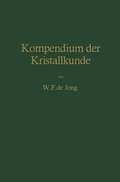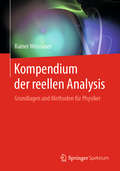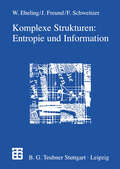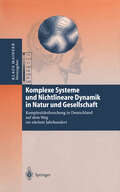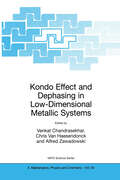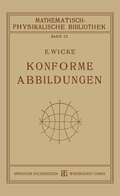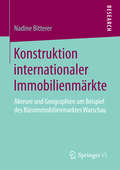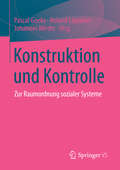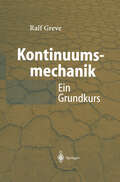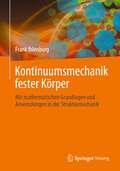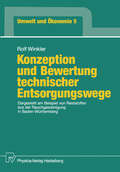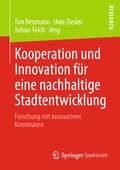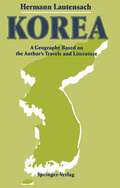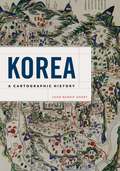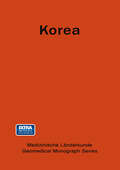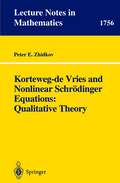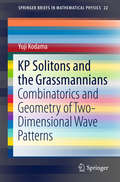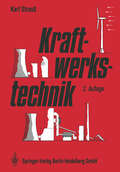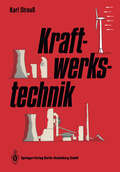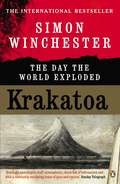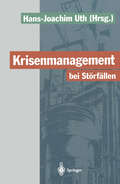- Table View
- List View
Kompendium der reellen Analysis: Grundlagen und Methoden für Physiker
by Rainer WeissauerDieses Buch stellt die für Physiker relevanten Begriffe und Methoden der Analysis übersichtlich zusammen. Es richtet sich an theoretisch interessierte Studierende ab dem dritten Bachelor-Semester, denen punktuell mathematische Grundlagen fehlen – etwa im weiteren Verlauf des Studiums (z. B. bei Veranstaltungen zu Elektrodynamik, Mechanik, Elementarteilchenphysik, …) oder im Rahmen von Abschlussarbeiten. Diese Studierenden finden in den kompakten, in sich geschlossenen Abschnitten des Buchs effiziente Hilfe. Für optimale Auffindbarkeit und Orientierung innerhalb des Buchs sorgen ein ausführliches Stichwortverzeichnis sowie einleitende Texte auf Kapitelebene: Letztere machen sowohl die jeweils notwendigen Voraussetzungen (z. B. die zum Verständnis notwendigen Begriffe) transparent und ermöglichen das Einordnen in den Kontext sowie das Herstellen von Querbezügen.
Komplexe Strukturen: Entropie und Information
by Jan Freund Frank SchweitzerDie Erforschung komplexer Strukturen ist gegenwärtig eines der interessantesten wissenschaftlichen Themen. Dieses Buch behandelt Möglichkeiten der Beschreibung und quantitativen Charakterisierung komplexer Strukturen mit Hilfe verschiedener Entropie- und Informationsmaße. Nach einer allgemein verständlichen Einführung der Grundbegriffe werden die für eine quantitative Analyse erforderlichen Konzepte ausführlich behandelt und an zahlreichen Beispielen, wie Zeitreihen, Biosequenzen, literarischen Texten und Musikstücken, veranschaulicht.
Komplexe Systeme und Nichtlineare Dynamik in Natur und Gesellschaft: Komplexitätsforschung in Deutschland auf dem Weg ins nächste Jahrhundert
by Klaus MainzerKomplexe dynamische Systeme werden in verschiedenen Wissenschaftsdisziplinen untersucht - von Physik, Chemie, Biologie und Medizin über Kognitionswissenschaften und Psychologie bis zu Soziologie und Ökonomie. Dieser Band zieht Bilanz und zeigt künftige Forschungsperspektiven auf. Gemeinsames methodisches Thema ist die Modellierung komplexer Systeme, deren Dynamik durch Nichtlinearität bestimmt ist. Mathematische Methoden und Computersimulationen machen aber nur Sinn, wenn sie mit konkreten einzelwissenschaftlichen Analysen verbunden sind. Das Buch liefert nicht nur fachübergreifende Informationen über den aktuellen Forschungsstand, sondern kann auch von Nichtspezialisten als Einführung in das spannende Gebiet komplexer Systeme und nichtlinearer Dynamik in Natur und Gesellschaft gelesen werden.
Kondo Effect and Dephasing in Low-Dimensional Metallic Systems (NATO Science Series II: Mathematics, Physics and Chemistry #50)
by Venkat Chandrasekhar Chris Van Haesendonck Alfred ZawadowskiThe NATO Advanced Research Workshop took place from 29 May to I June 2000 in the picturesque Hungarian town of Pecs, 220 km south of Budapest. The main goal of the workshop was to review and promote experimental and theoretical research on the problem of Kondo-type scatteringofthe electrons in systems ofreduced dimensionalities. 53 regular participants and 7 observers from 17 different countries attended the workshop. The Kondo effect has been a topic ofintense interest for many years, due in part to its relevance to a variety of other branches of condensed matter physics. In addition to the best known example of magnetic impurities in noble metals, the physics of the Kondo effect is important in many areas of current research, including heavy-fermion physics, correlated electron systems, and high-temperature superconductivity. Of central importance in this problem is the interaction of conduction electrons in the metal with individual magnetic impurities, an interaction which also mediates the interaction ofthe impurities with each other.
Konforme Abbildungen (Mathematisch-physikalische Bibliothek)
by E. WickeDieser Buchtitel ist Teil des Digitalisierungsprojekts Springer Book Archives mit Publikationen, die seit den Anfängen des Verlags von 1842 erschienen sind. Der Verlag stellt mit diesem Archiv Quellen für die historische wie auch die disziplingeschichtliche Forschung zur Verfügung, die jeweils im historischen Kontext betrachtet werden müssen. Dieser Titel erschien in der Zeit vor 1945 und wird daher in seiner zeittypischen politisch-ideologischen Ausrichtung vom Verlag nicht beworben.
Konstruktion internationaler Immobilienmärkte: Akteure und Geographien am Beispiel des Büroimmobilienmarktes Warschau
by Nadine BittererDas Ziel der Untersuchung von Nadine Bitterer ist die Aufdeckung handlungsanleitender Logiken und Praktiken, die eine zunehmende internationale Integration sowie scheinbar mobile Zirkulation von Immobilienanlagen ermöglichen. Am Beispiel des Büroimmobilienmarktes Warschaus, der gerade in den letzten zehn Jahren zu einem attraktiven Anlageziel professioneller institutioneller Immobilieninvestoren wurde, analysiert sie, wie lokale Märkte in eine sich zunehmend internationalisierende Immobilienwirtschaft integriert werden. Und dies vor dem Hintergrund einer zunehmenden Internationalisierung der Immobilienwirtschaft, die sowohl in einer enormen Ausweitung grenzüberschreitender Immobilieninvestitionen als auch in zunehmenden geographischen Ausdehnungen internationaler Verflechtungen von Immobilienmärkten sichtbar wird.
Konstruktion und Kontrolle: Zur Raumordnung sozialer Systeme
by Pascal Goeke Roland Lippuner Johannes WirthsWie verändern sich gesellschaftliche Raumordnungen im Zuge der Ökologisierung, Mediatisierung, Globalisierung und Technisierung der Weltverhältnisse? Welche Möglichkeiten der (Neu-)Gestaltung gesellschaftlicher Raumordnungen bestehen, wenn deutlich wird, dass dabei mit einem vielfach besiedelten Außen zu rechnen ist, das von der Gesellschaft aus nicht vollständig kontrolliert werden kann? Der vorliegende Band widmet sich diesen Fragen im Horizont des Wissenschaftsprogramms Systemtheorie. Gezeigt wird, dass eine gesellschaftliche Kontrolle des Raums nur auf der Basis der sozialen Konstruktion von Raum als eine fortlaufende Sequenz von Kontrollversuchen zu denken ist, das heißt als ein ständiges Überprüfen und Nachjustieren bestehender Raumordnungen. Weil die Systemtheorie bei dieser Auseinandersetzung mit den Außenbeziehungen der Gesellschaft an ihre konzeptionellen Grenzen stößt, werden die Theoriebezüge in verschiedenen Beiträgen erweitert. Im Ergebnis zeichnen sich Perspektiven einer allgemeinen Ökologie im Sinne eines Denkens in Nachbarschaften ab.
Kontinuumsmechanik: Ein Grundkurs für Ingenieure und Physiker
by Ralf GreveDieses Buch behandelt die grundlegenden Konzepte der Kontinuumsmechanik, also der klassischen Feldtheorie der deformierbaren Körper. Die Theorie wird systematisch von der Kinematik über die Bilanzgleichungen, die Materialtheorie und die Entropieprinzipien entwickelt. Als konkrete Anwendungen werden ausführlich der linear-elastische Festkörper, die ideale Flüssigkeit und die Newtonsche Flüssigkeit vorgestellt. Das Buch schließt mit einer Einführung in die Mischungstheorie. Generell wird Wert auf eine klare und verständliche Darstellung gelegt, die lediglich elementare Kenntnisse der Analysis, linearen Algebra und Newtonschen Mechanik voraussetzt. Der Text wird ergänzt durch eine Vielzahl von ausgearbeiteten Problemen unterschiedlicher Schwierigkeit, die den Leser und die Leserin dazu einladen, sich aktiv mit der Materie auseinanderzusetzen. Das Buch wendet sich an Studenten und Studentinnen der Physik, Mechanik, Ingenieur- und Geowissenschaften sowie der Angewandten Mathematik nach dem Vordiplom.
Kontinuumsmechanik fester Körper: Mit mathematischen Grundlagen und Anwendungen in der Strukturmechanik
by Frank IhlenburgDas Lehr- und Übungsbuch ist im Stil der Standardliteratur zur Technischen/Höheren Mechanik geschrieben und schließt inhaltlich an diese an. Theoretische Zusammenhänge werden mit Beispielen und Grafiken illustriert, dazu Übungsaufgaben mit durchgerechneten Lösungen im Anhang. Zielgruppe sind Studierende des Ingenieurwesens und praktisch tätige Ingenieure werden bei nichtlinearen Finite-Elemente-Simulationen unterstützt. In der Verknüpfung FEM-CAD setzt sich die kontinuumsmechanische Modellierung mit Volumenelementen durch, zudem wird Stahl oft durch nichtmetallische Werkstoffe ersetzt. Die Kapitel zur Materialtheorie tragen diesen Trends Rechnung. Weitere Themen sind Kinematik und Kinetik großer Deformationen sowie mathematische und thermodynamische Grundlagen. Für Elastizität und Plastizität wird jeweils auch das viskose Verhalten diskutiert. Das Materialverhalten bei großen Deformationen wird im Kontext mit der linearen Theorie und einfachen FE-Simulationen erläutert.
Konzeption und Bewertung technischer Entsorgungswege: Dargestellt am Beispiel von Reststoffen aus der Rauchgasreinigung in Baden-Württemberg (Umwelt und Ökonomie #5)
by Rolf WinklerKooperation und Innovation für eine nachhaltige Stadtentwicklung: Forschung mit innovativen Kommunen
Die Autoren stellen die Ergebnisse des Projekts IER-SEK zusammenfassend vor. IER-SEK ist das Instrument zur Entscheidungsunterstützung für Großvermieter zur Realisierung von Stadtentwicklungskonzepten und wurde im Rahmen der BMBF-Initiative Kommunen innovativ gefördert. Das Buch gibt aber auch einen Ausblick auf weitere Themen, welche die nachhaltige Stadtentwicklung beeinflussen, dazu gehören Stadtentwicklung und Mensch sowie Technologie und Energie.Die Herausgeber:M.Sc. Tim Neumann ist wissenschaftlicher Mitarbeiter an der Westsächsischen Hochschule Zwickau. Dipl.-Ing. Uwe Ziesler arbeitet in der Stabsstelle Stadtentwicklung der Stadt Zwickau. Prof. Dr. rer. pol. habil. Dr.-Ing. Tobias Teich ist Professor für Vernetzte Systeme in der Betriebswirtschaft an der Westsächsischen Hochschule Zwickau.
Korea: A Geography Based on the Author’s Travels and Literature
by Hermann LautensachLautensach[s "Korea" is a regional geography, the most comprehensive one ever written on Korea in a western language. It was written before the country was divided and provides a waelth of information on the entire country, particularly on the north, something that has been difficult toobtain in the West in the past forty years. Unfortunately, only very few volumes survived the end of World War II, so that it has been very difficultto get hold of the book. Lautensachh[s "Korea" is considered a classical example of regional geography.
Korea: A Cartographic History
by John Rennie ShortThe first general history of Korea as seen through maps, Korea: A Cartographic History provides a beautifully illustrated introduction to how Korea was and is represented cartographically. John Rennie Short, one of today’s most prolific and well-respected geographers, encapsulates six hundred years of maps made by Koreans and non-Koreans alike. Largely chronological in its organization, Korea begins by examining the differing cartographic traditions prevalent in the early Joseon period in Korea—roughly 1400 to 1600—and its temporal equivalent in early modern Europe. As one of the longest continuous dynasties, Joseon rule encompassed an enormous range and depth of cartographic production. Short then surveys the cartographic encounters from 1600 to 1900, distinguishing between the early and late Joseon periods and highlighting the influences of China, Japan, and the rest of the world on Korean cartography. In his final section, Short covers the period from Japanese colonial control of Korea to the present day and demonstrates how some of the tumultuous events of the past hundred years are recorded and contested in maps. He also explores recent cartographic controversies, including the naming of the East Sea/Sea of Japan and claims of ownership of the island of Dokdo. A common theme running throughout Short’s study is how the global flow of knowledge and ideas affects mapmaking, and Short reveals how Korean mapmakers throughout history have embodied, reflected, and even contested these foreign depictions of their homeland.
Korea: A Cartographic History
by John Rennie ShortThe first general history of Korea as seen through maps, Korea: A Cartographic History provides a beautifully illustrated introduction to how Korea was and is represented cartographically. John Rennie Short, one of today’s most prolific and well-respected geographers, encapsulates six hundred years of maps made by Koreans and non-Koreans alike. Largely chronological in its organization, Korea begins by examining the differing cartographic traditions prevalent in the early Joseon period in Korea—roughly 1400 to 1600—and its temporal equivalent in early modern Europe. As one of the longest continuous dynasties, Joseon rule encompassed an enormous range and depth of cartographic production. Short then surveys the cartographic encounters from 1600 to 1900, distinguishing between the early and late Joseon periods and highlighting the influences of China, Japan, and the rest of the world on Korean cartography. In his final section, Short covers the period from Japanese colonial control of Korea to the present day and demonstrates how some of the tumultuous events of the past hundred years are recorded and contested in maps. He also explores recent cartographic controversies, including the naming of the East Sea/Sea of Japan and claims of ownership of the island of Dokdo. A common theme running throughout Short’s study is how the global flow of knowledge and ideas affects mapmaking, and Short reveals how Korean mapmakers throughout history have embodied, reflected, and even contested these foreign depictions of their homeland.
Korea: A Geomedical Monograph of the REPUBLIC OF KOREA (Medizinische Länderkunde Geomedical Monograph Series #6)
by Chin-thack SohFor over 30 years I have been engaged as a parasitolo nitz, Springer-Verlag, Heidelberg, was arranged in the pres gist in research on endemic diseases in our land. However, ence of Professor Jusatz. lt was indeed a great honor for I have been somewhat dissatisfied within my heart of me, but I also felt a very heavy responsibility; how to set hearts from the point of view of a medical person. Most of up the scheme, how to collect the materials, how to di gest, analyze and compile them in accordance with the us, myself included, handle disease sectionally, not com prehensively. Clinicians pay more attention to finding ef original goals. I frankly confess to realizing how limited fective drugs, medical scientists concentrate more effort my knowledge was at the same time. Poor editing would on clarifying pathologic etiology, and public health work result in dishonor not only to myself, but to my country ers are more concerned with environmental sanitation. as well. Now at this juncture, the point of editing, I am filled Thus, most of us generally neglect to search out the with deep emotion. In spite of limited time and knowl causal relation of a certain disease. For a disease to be established various factors must be involved: agent, ecolo edge, this manuscript will be prepared for edition at all gy, hosts, carriers, transmitters, habits, geographic and events.
Korteweg-de Vries and Nonlinear Schrödinger Equations: Qualitative Theory (Lecture Notes in Mathematics #1756)
by Peter E. Zhidkov- of nonlinear the of solitons the the last 30 theory partial theory During years - has into solutions of a kind a differential special equations (PDEs) possessing grown and in view the attention of both mathematicians field that attracts physicists large and of the of the problems of its novelty problems. Physical important applications for in the under consideration are mo- to the observed, example, equations leading mathematical discoveries is the Makhankov One of the related V.G. by [60]. graph from this field methods that of certain nonlinear by equations possibility studying inverse these to the problem; equations were analyze quantum scattering developed this method of the inverse called solvable the scattering problem (on subject, are by known nonlinear At the the class of for same time, currently example [89,94]). see, the other there is solvable this method is narrow on hand, PDEs sufficiently and, by of differential The latter called the another qualitative theory equations. approach, the of various in includes on pr- investigations well-posedness approach particular solutions such or lems for these the behavior of as stability blowing-up, equations, these and this of approach dynamical systems generated by equations, etc., properties in wider class of a makes it to an problems (maybe possible investigate essentially more general study).
KP Solitons and the Grassmannians: Combinatorics and Geometry of Two-Dimensional Wave Patterns (SpringerBriefs in Mathematical Physics #22)
by Yuji KodamaThis is the first book to treat combinatorial and geometric aspects of two-dimensional solitons. Based on recent research by the author and his collaborators, the book presents new developments focused on an interplay between the theory of solitons and the combinatorics of finite-dimensional Grassmannians, in particular, the totally nonnegative (TNN) parts of the Grassmannians.The book begins with a brief introduction to the theory of the Kadomtsev–Petviashvili (KP) equation and its soliton solutions, called the KP solitons. Owing to the nonlinearity in the KP equation, the KP solitons form very complex but interesting web-like patterns in two dimensions. These patterns are referred to as soliton graphs. The main aim of the book is to investigate the detailed structure of the soliton graphs and to classify these graphs. It turns out that the problem has an intimate connection with the study of the TNN part of the Grassmannians. The book also provides an elementary introduction to the recent development of the combinatorial aspect of the TNN Grassmannians and their parameterizations, which will be useful for solving the classification problem.This work appeals to readers interested in real algebraic geometry, combinatorics, and soliton theory of integrable systems. It can serve as a valuable reference for an expert, a textbook for a special topics graduate course, or a source for independent study projects for advanced upper-level undergraduates specializing in physics and mathematics.
Kraal (Large Print)
by Rnib BookshareThis is a plan view (seen from above) of a Masai settlement often called a kraal: an Afrikaans or Dutch name for a village.The plan is bounded by a dashed line image border. There is a locator dot shown, which will be at the top left of the page when the image is the correct way up.A kraal is a roughly circular arrangement of dwellings, with pens for animals, such as cattle, sheep and goats, at its centre. In this plan view the animal pens have a heavy dashed outline with a square grid texture (coloured brown in the large print) and the dwellings have a solid outline with a light dotted texture (yellow in the large print). he dwellings are made from a mix of mud, sticks, grass and cow dung. The pens are usually made from the thorny branches of the native acacia tree. They are put at the centre of the settlement to protect the animals from wild predators such as lions. Sometime the whole village is surrounded by a thorny fence.In Masai culture the building of shelters has traditionally been the responsibility of the women of the tribe.
Kraal (UEB Contracted)
by Rnib BookshareThis is a plan view (seen from above) of a Masai settlement often called a kraal: an Afrikaans or Dutch name for a village.The plan is bounded by a dashed line image border. There is a locator dot shown, which will be at the top left of the page when the image is the correct way up.A kraal is a roughly circular arrangement of dwellings, with pens for animals, such as cattle, sheep and goats, at its centre. In this plan view the animal pens have a heavy dashed outline with a square grid texture (coloured brown in the large print) and the dwellings have a solid outline with a light dotted texture (yellow in the large print). he dwellings are made from a mix of mud, sticks, grass and cow dung. The pens are usually made from the thorny branches of the native acacia tree. They are put at the centre of the settlement to protect the animals from wild predators such as lions. Sometime the whole village is surrounded by a thorny fence.In Masai culture the building of shelters has traditionally been the responsibility of the women of the tribe.
Kraal (UEB Uncontracted)
by Rnib BookshareThis is a plan view (seen from above) of a Masai settlement often called a kraal: an Afrikaans or Dutch name for a village.The plan is bounded by a dashed line image border. There is a locator dot shown, which will be at the top left of the page when the image is the correct way up.A kraal is a roughly circular arrangement of dwellings, with pens for animals, such as cattle, sheep and goats, at its centre. In this plan view the animal pens have a heavy dashed outline with a square grid texture (coloured brown in the large print) and the dwellings have a solid outline with a light dotted texture (yellow in the large print). he dwellings are made from a mix of mud, sticks, grass and cow dung. The pens are usually made from the thorny branches of the native acacia tree. They are put at the centre of the settlement to protect the animals from wild predators such as lions. Sometime the whole village is surrounded by a thorny fence.In Masai culture the building of shelters has traditionally been the responsibility of the women of the tribe.
Kraftwerkstechnik: zur Nutzung fossiler, regenerativer und nuklearer Energiequellen (VDI-Buch)
by Karl StraußMotor des technischen Fortschritts und der Entwicklung des Wohlstandes in den Industrieländern ist die elektrische Energie. Seit etwa 110 Jahren wird sie im industriellen Maßstab durch Energiewandlung mit Kraftwerken zur allgemeinen Verwendung bereitgestellt. Das vorliegende Buch liefert dazu den heutigen Stand der Technik und weist auf zukünftige Entwicklungsmöglichkeiten hin. Der Autor behandelt folgende Aspekte: Übersicht über die verfügbaren Energiequellen (fossil, regenerativ, nuklear) - Prinzipien zur Umwandlung der jeweiligen Primärenergie in Strom - aus der Energieumwandlung resultierende Umweltbelastungen - Aussagen über Wirkungsgrade, Anlagenverfügbarkeit und Kosten. Durch Beispiele mit Lösungen kann der Leser Größenordnungen von Energie- und Stoffströmen sowie Abmessungen von Komponenten und Bauteilen abschätzen. Das Buch wendet sich an Studenten und in der Praxis tätige Ingenieure der Energie- und Kraftwerkstechnik.
Krakatoa: The Day the World Exploded
by Simon WinchesterSimon Winchester's brilliant chronicle of the destruction of the Indonesian island of Krakatoa in 1883 charts the birth of our modern world. He tells the story of the unrecognized genius who beat Darwin to the discovery of evolution; of Samuel Morse, his code and how rubber allowed the world to talk; of Alfred Wegener, the crack-pot German explorer and father of geology. In breathtaking detail he describes how one island and its inhabitants were blasted out of existence and how colonial society was turned upside-down in a cataclysm whose echoes are still felt to this day.
Krisenmanagement bei Störfällen: Vorsorge und Abwehr der Gefahren durch chemische Stoffe
by Hans Joachim UthDas vorliegende Buch Krisenmanagement bei Störfällen gibt eine umfassende Charakterisierung des Problemkreises industrieller Störfälle und deren Kontrolle durch Managementkonzepte. Insbesondere werden die für ein wirksames Krisenmangement zu beachtenden Bereiche analysiert und Erfahrungen mit der praktischen Handhabung der Krise mitgeteilt. Es richtet sich sowohl an Umweltschutzbeauftragte, Werksleiter, Betriebsorganisatoren und die obersten Managementebenen in Industriebetrieben mit Anlagen, die der Störfallverordnung unterliegen, als auch an Consultants, die entsprechende Beratungen durchführen.
